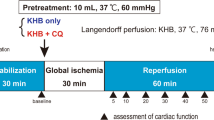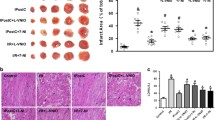Abstract
Objective: Experimental results from cultured cells suggest that there is cross-talk between nitric oxide (NO) and extracellular signal-regulated kinase (ERK) in their anti-apoptotic effect. However, the cross-talk between these two molecules in either direction has not been confirmed in the whole organ or whole animal level. The aim of the present study was to determine whether ERK may play a role in the anti-apoptotic and cardioprotective effects of NO in myocardial ischemia/reperfusion (MI/R). Methods: Isolated perfused mouse hearts were subjected to 20 min of global ischemia and 120 min of reperfusion and treated with vehicle or an NO donor (SNAP, 10 μM) during reperfusion. To determine the role of ERK1/2 in the anti-apoptotic and cardioprotective effects of NO, hearts were pre-treated (10 min before ischemia) with U0126, a selective MEK1/2 inhibitor (1 μM). Results: Treatment with SNAP exerted significant cardioprotective effects as evidenced by reduced cardiac apoptosis (TUNEL and caspase 3 activity, p < 0.01), and improved cardiac functional recovery (p < 0.01). In addition, treatment with SNAP resulted in a 2.5-fold increase in ERK activation when compared with heart receiving vehicle. Pre-treatment with U0126 slightly increased post-ischemic myocardial apoptosis but had no significant effect on cardiac functional recovery in this isolated perfused heart model. However, treatment with U0126 completely blocked SNAP-induced ERK activation and markedly, although not completely, inhibited the cardioprotection exerted by SNAP. Conclusion: These results demonstrate that nitric oxide exerts its anti-apoptotic and cardioprotective effects, at least in part, by activation of ERK in ischemic/reperfused heart.
Similar content being viewed by others
References
Gottlieb RA, Engler RL. Apoptosis in myocardial ischemia-reperfusion. Ann NY Acad Sci 1999; 874: 412–426.
Paulus WJ. The role of nitric oxide in the failing heart. Heart Fail Rev 2001; 6: 105–118.
Marletta MA, Maxey KM. Nitric oxide: function, Formation and therapeutic potential. Cayman Chemical 1995; 1: 1–5.
Liu GL, Christopher TA, Lopez BL, et al. SP/W-5186, a cysteine-containing nitric oxide donor, attenuates post-ischemic myocardial injury. J Pharm Experim Therap 1998; 287: 527–537.
Johnson GL, Lapadat R. Mitogen-activated protein kinase pathways mediated by ERK, JNK, and p38 protein kinases. Science 2002; 298: 1911–1912.
Abe Ji, Baines CP, Berk BC. Role of mitogen-activated protein kinases in ischemia and reperfusion injury : The good and thebad. Circul Res 2000; 86: 607–609.
Yue TL, Wang C, Gu JL, et al. Inhibition of extracellular signal-regulated kinase enhances ischemia/reoxygenation-induced apoptosis in cultured cardiac myocytes and exaggerates reperfusion injury in isolated perfused heart. Circ Res 2000; 86: 692–699.
Ma XL, Kumar S, Gao F, et al. Inhibition of p38 mitogen-activated protein kinase decreases cardiomyocyte apoptosis and improves cardiac function after myocardial ischemia and reperfusion. Circulation 1999; 99: 1685–1691.
Chae HJ, Kim HR, Kwak YG, Ko JK, Joo CU, Chae SW. Signal transduction of nitric oxide donor-induced protection in hydrogen peroxide-mediated apoptosis in H9C2 cardiomyoblasts. Immunopharm Immunotox 2001; 23: 187–204.
Rakhit RD, Kabir AN, Mockridge JW, Saurin A, Marber MS. Role of G proteins and modulation of p38 MAPK activation in the protection by nitric oxide against ischemia-reoxygenation injury. Biochem Biophys Res Commun 2001; 286: 995–1002.
Yun HY, Gonzalez-Zulueta M, Dawson VL, Dawson TM. Nitric oxide mediates N-methyl-D-aspartate receptor-induced activation of p21ras. Proc Natl Acad Sci USA 1998; 95: 5773–5778.
Boyd CS, Cadenas E. Nitric oxide and cell signaling pathways in mitochondrial-dependent apoptosis. Biol Chem 2002; 383: 411–423.
Rossig L, Haendeler J, Hermann C, et al. Nitric oxide down-regulates MKP-3 mRNA levels: involvement in endothelial cell protection from apoptosis. J Biol Chem 2000; 275: 25502–25507.
Gao F, Gao E, Yue TL, et al. Nitric oxide mediates the antiapoptotic effect of insulin in myocardial ischemia-reperfusion: the roles of PI3-kinase, Akt, and endothelial nitric oxide synthase Phosphorylation. Circulation 2002; 105: 1497–1502.
Liu HR, Tao L, Gao E, et al. Anti-apoptotic effects of rosiglitazone in hypercholesterolemic rabbits subjected to myocardial ischemia and reperfusion. Cardiovasc Res 2004; 62: 135–144.
Tao L, Gao E, Bryan NS, et al. Cardioprotective effects of thioredoxin in myocardial ischemia and reperfusion: Role of S-nitrosation. Proc Nat Acad Sci 2004; 101: 11471–11476.
Frodin M, Gammeltoft S. Role and regulation of 90 kDa ribosomal S6 kinase (RSK) in signal transduction. Mol Cell Endocr 1999; 151: 65–77.
Takahashi E, Abe Ji, Gallis B et al. p90RSK is a serum-stimulated Na+/H+ exchanger isoform-1 kinase. Regulatory Phosphorylation of Serine 703 of Na+/H+ exchanger isoform-1. J Biol Chem 1999; 274: 20206–20214.
Fang X, Yu S, Eder A, et al. Regulation of BAD phosphorylation at serine 112 by the Ras-mitogen- activated protein kinase pathway. Oncogene 1999; 18: 6635–6640.
Scheid MP, Schubert KM, Duronio V. Regulation of bad phosphorylation and association with Bcl-x(L) by the MAPK/Erk kinase. J Biol Chem 1999; 274: 31108–31113.
Scheid MP, Schubert KM, Duronio V. Regulation of bad phosphorylation and association with Bcl-xL by the MAPK/Erk kinase. J Biol Chem 1999; 274: 31108–31113.
Scheid MP, Duronio V. Dissociation of cytokine-induced phosphorylation of Bad and activation of PKB/akt: Involvement of MEK upstream of bad phosphorylation. Proc Nat Acad Sci 1998; 95: 7439–7444.
Baines CP, Zhang J, Wang GW, et al. Mitochondrial PKCepsilon and MAPK Form Signaling Modules in the Murine Heart: Enhanced mitochondrial PKCepsilon-MAPK interactions and differential MAPK activation in PKCepsilon-induced cardioprotection. Circul Res 2002; 90: 390–397.
Bonni A, Brunet A, West AE, Datta SR, Takasu MA, Greenberg ME. Cell survival promoted by the Ras-MAPK signaling pathway by transcription-dependent and -independent mechanisms. Science 1999; 286: 1358–1362.
Tan Y, Ruan H, Demeter MR, Comb MJ. p90RSK blocks bad-mediated cell death via a protein kinase C-dependent pathway. J Biol Chem 1999; 274: 34859–34867.
Weyrich AS, Ma XL, Lefer AM. The role of L-arginine in ameliorating reperfusion injury after myocardial ischemia in the cat. Circulation 1992; 86: 279–288.
Beckman JS. Parsing the effects of nitric oxide, S-nitrosothiols, and peroxynitrite on inducible nitric oxide synthase-dependent cardiac myocyte apoptosis. Circulation Reserach 1999; 85: 870–871.
Chung HT, Pae HO, Choi BM, Billiar TR, Kim YM. Nitric oxide as a bioregulator of apoptosis. Biochem Biophys Res Commun 2001; 282: 1075–1079.
Muda M, Boschert U, Dickinson R, et al. MKP-3, a novel cytosolic protein-tyrosine phosphatase that exemplifies a new class of mitogen-activated protein kinase phosphatase. J Biol Chem 1996; 271: 4319–4326.
Callsen D, Pfeilschifter J, Brune B. Rapid and delayed p42/p44 mitogen-activated protein kinase activation by nitric oxide: the role of cyclic GMP and tyrosine phosphatase inhibition. J Immunol 1998; 161: 4852–4858.
Author information
Authors and Affiliations
Corresponding author
Additional information
The first two authors contribute equally to this study.
Rights and permissions
About this article
Cite this article
Li, DY., Tao, L., Liu, H. et al. Role of ERK1/2 in the anti-apoptotic and cardioprotective effects of nitric oxide after myocardial ischemia and reperfusion. Apoptosis 11, 923–930 (2006). https://doi.org/10.1007/s10495-006-6305-6
Published:
Issue Date:
DOI: https://doi.org/10.1007/s10495-006-6305-6




